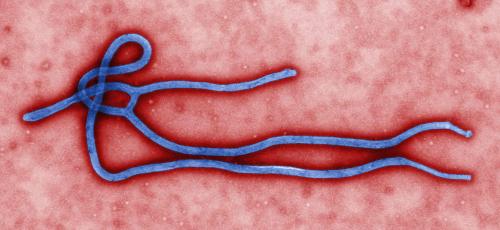Comparison of Host Responses to Ebola Virus Disease (EVD)
Study expanded to apply technology used for the Ebola project to gather important information about COVID-19 infection (March 2020)

Background | Project Description | Project Outcomes | Update: COVID-19
Performer: UK Health Security Agency (UKHSA, formerly Public Health England [PHE])
Project leader: Miles W. Carroll, PhD
Initial contract value: $1,460,342 (base award, 2017)
Contract option value: $931,792 (2018)
Contract modification value: $250,000 (March 2020)
Project dates: October 2017 - October 2022
View a July 2021 FDA Grand Rounds lecture about this research: SARS-CoV-2 Host-Pathogen Interaction, Vaccines & Variants of Concern - webcast (1 hour, 6 minutes) - about this lecture
Background
The West African Ebola epidemic of 2014-2015 highlighted the threat posed by Ebola virus (EBOV), which causes Ebola virus disease (EVD) in humans and other animals. Currently, no antiviral therapies or vaccines have been demonstrated to be safe and effective for the treatment or prevention of EVD, and the development of such medical countermeasures remains a high priority. Given the severity of EVD, it would not be ethical or feasible to conduct human challenge studies (outside of a naturally occurring epidemic) to support the development of countermeasures. Outbreaks of many serious pathogens that require MCM development, including EVD, do not typically occur to an extent that supports the conduct of field efficacy studies in humans. As a result, data from well-controlled animal studies are usually necessary to determine whether a countermeasure is reasonably likely to produce clinical benefits in humans (as described in 21 CFR Parts 314.610 i.e., the Animal Rule).
Host responses (how the body fights infection) to EBOV are an important factor in delineating fatal from non-fatal outcomes. This project, comparing data from humans and other animals, will contribute to our understanding of host responses to EBOV, and will help FDA assess how well various animal models represent EVD disease in humans.
Project Description
In this three-year project, the UK Health Security Agency & Liverpool University will apply advanced transcriptomic analysis (the study of all messenger RNA from the genes of an organism) to compare responses to EVD in humans and in animals. Specifically, UKHSA will analyze at least 400 existing tissue samples from previous animal studies (EBOV challenge studies; eliminating the need for additional animals) and compare the data to transcriptomics analysis from Ebola patients that was generated in an FDA-funded project led by Prof. Miles Carroll in partnership with Prof. Julian Hiscox (University of Liverpool, UK). Tissue samples will be provided by multiple collaborative partners from; Australia, Canada, France, USA, UK.
This project will help identify biomarkers of EVD, and expected disease outcomes.
Project Outcomes
Deliverables from this project include:
- Identifying host response biomarkers of disease progression through using host gene expression analysis of tissue samples from animal models of EBOV infection.
- Correlating host response with pathology of disease in different animal models, and comparing to data from an ongoing project in humans with EVD.
- Assessing viral load and virus evolutionary rate, and comparing across different animal models and tissues, as well as assessing replication site and challenge strain.
By contributing to our understanding of host responses to EVD infection, this research may lead to better prediction of outcomes of EVD infection, development of new products to treat or prevent EVD, and help inform FDA’s evaluation of such products.
Update – March 2020 (COVID-19)
In March 2020, FDA modified this contract with UKHSA, including collaborators at the University of Liverpool (UoL) to apply technology used for the Ebola project to gather important information about COVID-19 infection. UKHSA and UoL are developing reagents and new methods to sequence the SARS-CoV-2 virus to create profiles of coronavirus for the rapid characterization of these viruses in humans and animal models. Ultimately, this study may support development and evaluation of medical countermeasures for COVID-19, including rapid diagnostics, therapeutics, and vaccines, and inform FDA evaluation of these products.
Additional Reading
Liu, X., Speranza, E., Muñoz-Fontela, C., et al. (2017). Transcriptomic signatures differentiate survival from fatal outcomes in humans infected with Ebola virus. In Genome Biology (Vol. 18, Issue 1). Springer Science and Business Media LLC. https://doi.org/10.1186/s13059-016-1137-3
Timothy, J. W. S., Hall, Y., Akoi-Boré, J., et al. (2019). Early transmission and case fatality of Ebola virus at the index site of the 2013–16 west African Ebola outbreak: a cross-sectional seroprevalence survey. In The Lancet Infectious Diseases (Vol. 19, Issue 4, pp. 429–438). Elsevier BV. https://doi.org/10.1016/s1473-3099(18)30791-6
Publications
- Carroll, M. Serological evidence of zoonotic filovirus exposure among bushmeat hunters in Guinea, Nature Comms (preprint in review) DOI: 10.21203/rs.3.rs-1347502/v1
- Longet, S., Leggio, C., Akoi-Boré, J., et al. Influence of landscape patterns on the exposure of LASV across diverse regions within the Republic of Guinea. EID (preprint in review) DOI: https://doi.org/10.1101/2022.02.28.22271612
- Dong, X., Munoz-Basagoiti, J., Rickett, N.Y. et al. Variation around the dominant viral genome sequence contributes to viral load and outcome in patients with Ebola virus disease. Genome Biology; 2020 September 07. DOI: https://doi.org/10.1186/s13059-020-02148-3 - full text
- Bosworth, A., Rickett, N.Y., Dong, X. et al. Analysis of an Ebola virus disease survivor whose host and viral markers were predictive of death indicates the effectiveness of medical countermeasures and supportive care. Genome Med 13, 5 (2021). https://doi.org/10.1186/s13073-020-00811-9 - full text (open access)
- Ryan, K., Bewley, K., Fotheringham, S., Carroll, M., et al. Dose-dependent response to infection with SARS-CoV-2 in the ferret model: evidence of protection to re-challenge. bioRxiv; 2020 May, 29. DOI: doi: https://doi.org/10.1101/2020.05.29.123810 - full text (open access)
This project was funded through the MCMi Regulatory Science Extramural Research program.
